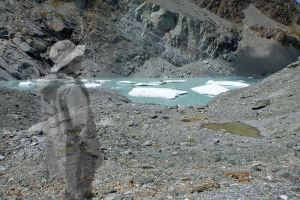INFINITEBOOK
"IN NATURE'S INFINITE BOOK OF SECRECY A LITTLE I CAN READ"
Beneath Ice and Water

A scuba diver swims the murky waters of the Egyptian coast, seeing nothing but fish, sea creatures and plants. Suddenly a massive face rears up at him. It is made of stone, its nose has broken away and it bears the cylindrical, stylised beard of an Egyptian pharaoh.
A hiker walks the Norwegian mountains, tracing the edge of a rapidly-receding glacier. She stops. Before her is a homemade tunic of rough wool, lying on the ground as if removed and casually thrown down yesterday.
In the early morning, a beachcomber searches the shoreline of Otterswick Bay in the Orkney Isles. The previous night, a storm raged over the islands, and he hopes to find rich pickings thrown up by the waves. At the low tide mark, the sand has been scoured away and in its place an ancient forest lies, blackened timbers fallen on a bed of black moss.
Archaeologists have a long tradition of studying the landscape for clues to hidden ancient cities and villages, long-disused religious sites and abandoned farmland. They carefully excavate sites covered in a few metres of earth, to learn about the lives of people who lived in or used such places thousands of years ago. But much of humankind's history is less accessible.
The world's geography has changed radically over history and prehistory. When ice ages occurred, sea levels fell and people lived in, hunted in and farmed areas of land that now lie metres below the sea surface. In other places, encroaching glaciers swallowed human habitations whole, burying them beneath impenetrable ice. Ancient cities, homes to thousands of people, were shaken into the ocean by earthquakes.
Lost City of Heraclion
One of the more recent losses to the waves was the Egyptian city, Heraclion. In 2001 Dr. Frank Goddio, an underwater archaeologist, discovered the city that saw the inauguration of Cleopatra lying beneath the waters of the Canopic coast. About 1200 years ago, Heraclion sank due to its own weight, rising sea levels and also possibly violent earth tremors. Its many extraordinary treasures, including more than 64 ships, multitudes of gold coins and weights, 5 metre statues, sarcophagi containing the mummified remains of sacrificed animals and stone blocks with ancient Greek and Egyptian inscriptions, have only recently been documented.
Iron Age Clothing
Melting glaciers are revealing more ancient artifacts. Humans have clothed themselves as protection from cold, rain and sun for thousands of years, but clothing is highly perishable and little remains to be studied that's more than a few hundred years old. Deep freezing is an effective way to preserve perishable items, however, as Marianne Vedeler of the University of Oslo found when she analysed an Iron Age tunic that appeared in the tracks of the retreating Norwegian Lendbreen glacier. Made from two different woollen fabrics, the tunic was simple and serviceable, designed to be pulled over the head. Among the last human hands to touch it between 1600 and 1800 years ago were those that sewed two repair patches.
Ancient Forests
The ancient legend of the bonnie woods of Otterswick gained credibility in 1838, when a massive storm briefly swept away the sand covering the drowned ancient forest off the coast of the now treeless Orkney Islands. The site soon disappeared again, but recently Dr Alistair Rennie of Scottish Natural Heritage rediscovered the wood and peat remains and sent off a sample for radiocarbon dating. Results indicated the forest is 6500 years old.
Before sea levels rose over the last few thousand years, much of the shallow seas off the coasts of the British Isles was dry land. We know this because evidence of human settlements have been brought up from waters as deep as 143 metres. In 1931, a trawler dredged up an antler spear 25 miles from the Norfolk coast, that was later determined to be 13000 years old. And beyond the tidemark at Borth in West Wales lie burnt stones and the solidified footprints of a small child.
What is still to be discovered is anyone's guess. But one thing's for sure -- more evidence of our ancestors lies yet to be found, beneath ice and water.
Please enjoy more of J.J. Green at INFINITEBOOK.
photo credit: apurdam (Andrew) via photopin cc.

The Piker Press moderates all comments.
Click here for the commenting policy.